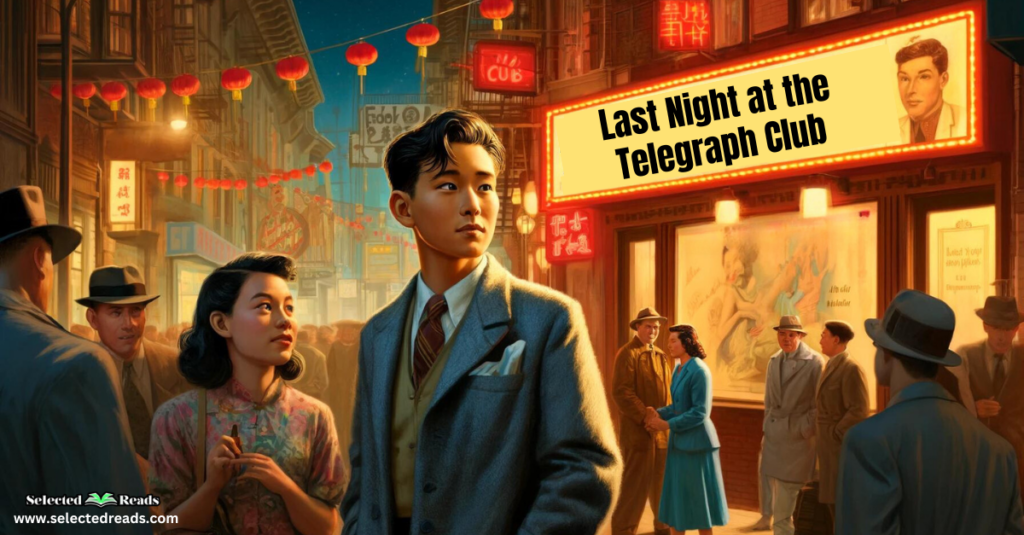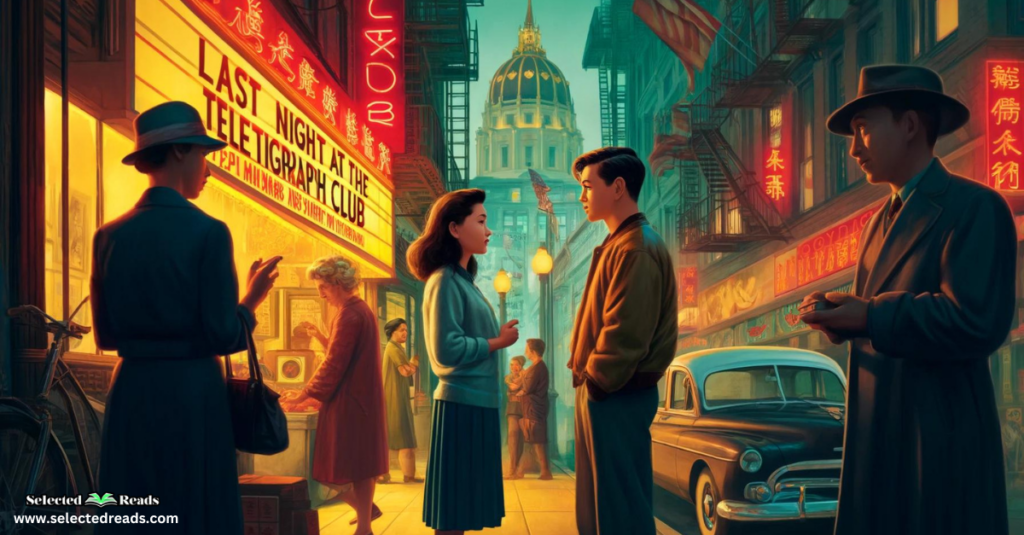Today, our focus is on “Last Night at the Telegraph Club” by Malinda Lo. This award-winning novel falls within the historical and LGBTQ+ fiction genres and offers a poignant glimpse into the life of a young Chinese American girl discovering her sexuality in 1950s San Francisco.
The purpose of this post is to give you a thorough yet spoiler-free introduction to the novel. My discussion will unfold in three parts: I will begin with a detailed summary of the story, then move on to an exploration of the key characters, and conclude with a set of thought-provoking discussion questions suitable for book clubs or personal reflection.
Last Night at the Telegraph Club Summary
“Last Night at the Telegraph Club” by Malinda Lo is set in 1954, a turbulent era in American history characterized by the Red Scare and significant societal conservatism, particularly in San Francisco’s Chinatown. The novel follows the life of seventeen-year-old Lily Hu, a high school student who is beginning to understand and embrace her identity as a lesbian.
The story begins with Lily discovering an ad for a male impersonator at a place called the Telegraph Club. Intrigued and feeling an unexplained pull towards the advertisement, Lily keeps it a secret, knowing her traditional Chinese-American family wouldn’t approve. Her life takes a turn when she befriends Kathleen Miller, a classmate who shares her interest in astronomy but also seems to understand the part of Lily that she keeps hidden.
As their friendship blossoms, they venture to the Telegraph Club, experiencing the thrill and liberation of a lesbian bar for the first time. It’s under the flashing neon lights that Lily truly allows herself to imagine a life where she can be honest about who she is and who she loves. However, the exhilaration of self-discovery and first love comes with its risks.
Photo: Amazon
Amidst their personal exploration, the broader societal pressures mount. The threat of McCarthyism looms large, casting a shadow over anyone who deviates from the norm. Lily’s family faces its own peril as her father, a Chinese immigrant, navigates the complexities of maintaining his citizenship amidst rising anti-Chinese sentiment and political scrutiny.
As Lily and Kath’s relationship deepens, they are forced to contend with the consequences of their choices. They navigate the dual challenges of a clandestine relationship and the external pressures of a society that is hostile towards their identities. The stakes are heightened when the reality of potential familial separation due to deportation becomes imminent for Lily.
Throughout the narrative, Lily grapples with her multiple identities—as a Chinese American, a daughter, and a young lesbian—struggling to find a balance between her desires and her obligations. The novel concludes with a poignant mix of hope and melancholy, encapsulating the emotional and social struggles of the time while celebrating the bravery it takes to pursue true self-acceptance.
Last Night at the Telegraph Club Characters
“Last Night at the Telegraph Club” features a cast of characters who bring depth and complexity to the story, each contributing to the central themes of identity, love, and societal challenges. Here are some key characters:
- Lily Hu – The protagonist of the story, Lily is a seventeen-year-old Chinese American girl who is navigating her sexual identity in a conservative era. Intelligent and curious, particularly about subjects like astronomy and engineering, Lily’s journey of self-discovery is at the heart of the novel.
- Kathleen (Kath) Miller – Kath is Lily’s classmate and becomes her closest confidante and love interest. She introduces Lily to the Telegraph Club and plays a crucial role in her exploration of her identity. Kath is more outwardly confident in her sexuality compared to Lily, providing a counterbalance to Lily’s cautiousness.
- Shirley Nakamoto – Shirley is one of Lily’s classmates and friends. She is Japanese American and, like Lily, faces her own cultural challenges. Shirley’s character provides a perspective on the different ways Asian Americans navigated their identities during the 1950s.
- Tommy Hu – Lily’s younger brother, who looks up to her. He provides a familial lens through which Lily’s actions are viewed, underscoring the family dynamics and the expectations placed on Lily.
- Mr. and Mrs. Hu – Lily’s parents, who represent the traditional values and expectations of Chinese immigrants during the 1950s. Mr. Hu is particularly focused on maintaining his family’s reputation and safety, especially given the political climate that threatens their stability in America.
- Aunt Judy – Lily’s aunt, who is more progressive and understanding than other older family members. She provides a supportive presence in Lily’s life, showing that acceptance can be found even within her own conservative community.
- Barb – A regular at the Telegraph Club and a part of the lesbian community in San Francisco. She becomes an important figure in showing Lily and Kath the possibilities of living openly, despite societal pressures.
Last Night at the Telegraph Club Discussion Questions
Here are some discussion questions that could help explore the novel’s complex themes and character dynamics:
- Exploring Identity and Acceptance: How does Lily’s Chinese American identity intersect with her sexual identity throughout the novel? In what ways do these dual identities both complicate and enrich her life?
- Historical Context: Discuss the impact of the Red Scare and McCarthyism on the characters in the book. How do these political climates specifically affect the Chinese American community depicted in the novel?
- The Role of Safe Spaces: How does the Telegraph Club serve as a safe space for Lily and Kath? What significance do safe spaces hold for marginalized communities, particularly during oppressive times?
- Family and Cultural Expectations: How do Lily’s familial and cultural expectations shape her actions and self-perception? Discuss the differences in generational attitudes toward sexuality and cultural assimilation within her family.
- Friendship and Relationships: Examine the relationship between Lily and Kath. How does their bond help them navigate the challenges they face? What role does friendship play in their journey compared to romantic love?
- Character Development: How does Lily evolve from the beginning of the novel to the end? Which events or interactions are pivotal in her development?
- Impact of Secrecy: What are the effects of secrecy on the characters’ lives in the novel? Consider the secrets kept by Lily, her family, and other characters. How does secrecy contribute to both survival and suffering?
- Representation and Visibility: Discuss the importance of representation and visibility for LGBTQ+ individuals during the 1950s as depicted in the novel. How might this story differ if set in today’s society?
- Ethics and Choices: Many characters in the novel make difficult choices to protect themselves or their loved ones. Discuss some of these choices and whether you agree with the decisions made.
- Symbolism and Imagery: What role does the imagery of space and astronomy play in the novel? How does it relate to the broader themes of exploration and discovery?
Related: The 57 Bus Summary and Discussion Questions
Final thoughts
To conclude, I trust this brief exploration of “Last Night at the Telegraph Club” has piqued your interest. This novel is not only a captivating narrative set in a transformative era but also a deep dive into personal discovery and societal challenges. If you haven’t yet had the chance to read it, I highly recommend doing so, as it offers a powerful reflection on identity, love, and resilience that resonates even today.








